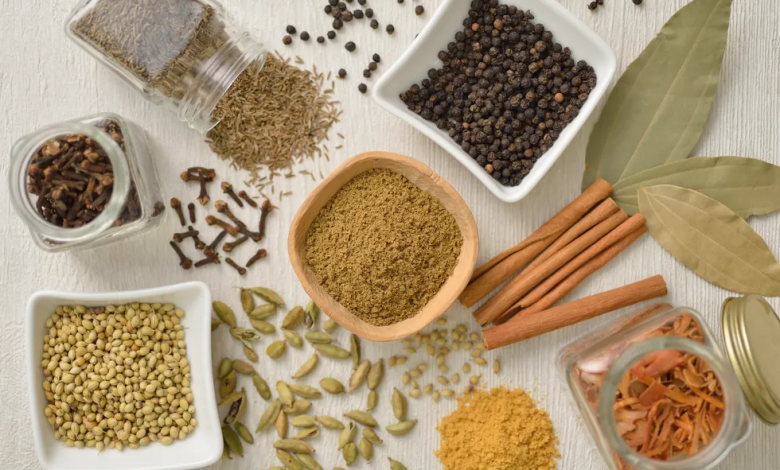A to Z about Garam Masala: Ingredients, Benefits, Uses

Garam masala, which means “spicy spice” in Hindi, is one of the most popular spice mixes in North Indian cuisine. Around ten different hot spices make up the authentic garam masala. All spices are roasted to perfection and ground to a fine powder, which is then used to impart a powerful, pungent flavor to a variety of cuisines. The name ‘garam’ in Ayurveda means ‘warming the body’, because the spices in garam masala are believed to raise body temperature. Masala is a popular Indian spice mix that adds flavor to any dish. The spices used in masala differ depending on the region.
Table of Contents
- What is Garam Masala?
- Ingredients
- Benefits
- Uses
What is Garam Masala?
Garam masala is an Indian spice mix that is frequently used in Indian cooking. which spices are usually roasted first and then ground to bring out more flavour and aroma. Although garam masala does not always imply a spicy combination, the term masala simply means “spices” and the adjective garam means “spicy”. Although garam masala paste should be checked on the label to identify what is in it, the powdered version is typically gluten-free, vegan, and vegetarian. Garam masala is a spice mix that can be found in curries, lentil dishes, and soups in Indian cuisine.
Ingredients
Garam masala is not a one size fits all recipe. Ingredients vary based on location and chef preferences. Ground garam masala is a popular spice mix that adds flavour to any dish. The spices used in ground GM differ by region. Some of the most popular ground spices used in typical North Indian cooking are black and white peppercorns, cloves, bay leaves, long pepper, black cumin, cumin seeds, and cinnamon. Mace and star anise, in addition to these spices, are common in most South Indian dishes.
In our Garam Masala powder, Badshah Masala uses the following spices:
- Chili
- coriander seeds
- Black pepper
- Anistar
- Fennel seeds
- cassia leaves
- Kothgal
- Cumin
- stone flower
- large cardamom
- Cassia
- Turmeric
- Nutmeg
- Cardamom
- Mallet
- black salt
- Nail
Health Benefits
You can imagine how healthy the spice mix would be given the number of spices used in its preparation. It should contain more than five spices, and each may have health-promoting properties that you should be aware of.
- The main advantage of using garam masala in your kitchen is that it stimulates the appetite and promotes digestion by promoting the release of gastric juices in the stomach.
- It is high in antioxidants, which help in preventing skin diseases and reducing inflammation.
- It has carminative properties that help with bloating, gas, and even nausea, as well as aiding digestion.
- GM is useful for treating bad breath as it contains cloves and cardamom.
- Spices like cloves, cinnamon, and cardamom have chemicals that can help the body lower and control cholesterol levels.
Uses
Garam masala is typically used to season and enhance the aroma of food at the end of the cooking process. You can sprinkle garam masala on top to finish the dish. Garam masala (GM) is traditionally made with whole spices and is used within a few days of preparation. It is not necessarily the only seasoning or spice in a dish.
- Garam Masala is used to season main dishes: Whether you are cooking with meat, turkey or vegetables, this spice will give your dish a distinctive flavour. For added flavour, mix and coat meat and vegetables with garam masala before cooking. Wait 30 minutes for the flavours to permeate the components.
- Fix the side dishes: GM is especially good with vegetables. In a large mixing bowl, combine all the vegetables. Then, to help the spices stick, sprinkle 1 to 3 tablespoons of olive oil over the vegetables.
- Garam Masala Desserts: Cupcakes are a great dessert option for a large group. You can use GM in regular cupcake batter or explore recipes that combine the spice with other flavours.
How To Make Garam Masala at Home
Our grandparents used to spend hours in the kitchen refining their spice blends back in the day. Although we’ve gone a long way, nothing compares to the flavour and aroma of handcrafted food powders.
The recipes listed below don’t take long to prepare, just require a few simple supplies from your local supermarket, and are straightforward to prepare. Because masala is used as a seasoning or flavouring, don’t forget to prepare some delectable foods before trying out these masala recipes.
Garam Masala vs. Curry Powder: What’s the Difference?
Curry powder and GM are both used to flavour and colour foods. One of the most noticeable distinctions between the two is that garam masala lacks Tumeric, which is one of the key ingredients in curry powder and lends a yellow tint to foods. GM is typically used as a last seasoning in a meal, stirred in near the end of the cooking process, whereas curry powder is used earlier.
3 Common Substitutes
If you don’t have all of the spices needed to make it, consider these substitutes:
Curry powder (curry powder): You can completely replace GM with curry powder in your recipe. Although you won’t get the same warming spices, curry powder’s flavour will complement most Indian recipes.
Cumin and allspice: When you’re in a rush, combine 4 parts ground cumin with 1 part allspice for a quick alternative.
Masala Chaat: As a replacement, try chaat masala. Amchoor, cumin, coriander, ginger, black pepper, asafetida, salt, and chile are all ingredients in this Indian spice blend. To avoid the spice overpowering your food, use smaller amounts and add it slowly.
Where to Buy
I advocate preparing your own garam masala at home—store-bought versions don’t come close to the flavour of homemade garam masala! If you’re in a hurry, try the Badshah Masala official website, which is available at most grocery stores and on Amazon.
Tips to remember when preparing Garam Masala
If you want to get the most out of your garam masala preparation, keep the following recommendations in mind. These suggestions were created with garam masala (ground spices) in mind.
- To form a paste, combine garam masala with coconut milk, vinegar, or water.
- More star anise can be added to the powder for added sweetness.
- To make your own unique recipe, change the quantities of the ingredients.
- To keep the powder, use an airtight jar made of food-grade plastic. This gives it a lengthy shelf life and allows you to use it as often as you want.
Read more articles here





